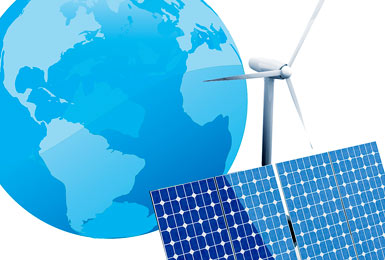Economic Geography's Vital Role in America's Alternative Energy Manufacturing Sector
For the renewable energy industry, site selection optimization goes well beyond incentives.
March 2011

State, federal, and municipal policies have catalyzed an alternative energy boom with manufacturing tax credits, local tax incentives, loan guarantees, feed-in tariffs, and utility-scale solar parks and wind farms. While incentives rank highly in location decision criteria for clean energy manufacturers, the most successful site selections will be those that pursue a competitive advantage by leveraging economic geography.
America's alternative energy manufacturing sectors have plenty of room to grow, especially as European and Asian companies are seeking opportunities for their developing and proven technologies and processes. In the United States, more than 60 new or upgraded solar manufacturing facilities (valued at $3.8 billion) have already used the first round of federal tax credits, according to the Solar Energy Industries Association (SEIA). The United States installed more wind capacity (10,010 MW) in 2009 than ever, but trailed both Europe (10,500 MW) and China (13,800 MW) according to the American Wind Energy Association (AWEA). Solar and wind manufacturing opportunities will likely continue to arise if the government enacts a proposed $5 billion expansion of the Advanced Manufacturing Tax Credit, along with $500 million in loan guarantees that have similarly supported biofuel refineries and geothermal power plants. No matter the pace of growth, or which countries achieve their target investment goals, one thing holds true: The leaders of this evolving industry must be more conscientious of where they locate their business and real estate operations - and why.
Clean Energy Enterprise Needs
As cleantech startups commercialize their research, they will face critical decisions: How do we structure our organization and business model to maximize success, and which geographies are the best fit when mapped against our enterprise needs? For established clean energy manufacturers, the question becomes: What is our best growth strategy (acquisition or organic), and how do we optimize our real estate portfolio (considering geography, critical resources and financial return) while minimizing risk?
As the recession thaws, more growth is expected, but many unknowns linger, particularly regarding uncertain U.S. energy and fiscal policies. From Oregon to New Jersey, solar panel manufacturing has clustered in states with the most competitive incentives, according to SEIA. But recent expansions in the wind industry have landed in almost every state in the nation and have not yet begun to develop any discernable clustering patterns. When factoring incentives, economic development policy, and local differentiators, the decision-making equation becomes daunting at an extraordinary scale. Incentives and subsidies alone have proven to be insufficient decision drivers, while optimizing for supply chain only may leave opportunities on the table to significantly reduce capitalization requirements or increase operational flexibility and innovation.
Cautionary tales are telling investors, developers, engineers, and government leaders that the next generation of collaboration must harness the strengths of economic geography, optimally matched to each enterprise's needs, in order to prosper - welcome news for both stakeholders and policymakers.
Project Announcements
Apex Plastics Opens Expanded Production Plant In Brookfield, Missouri
09/22/2014
Japan-Based Bridgestone Rubber-BSA Opens Biorubber Process Research Center In Mesa, Arizona
09/22/2014
SpencerARL Expands Its Plattsburgh, New York, Manufacturing Facility
09/22/2014
Hill International, Inc. Relocates Corporate Headquarters To Philadelphia, Pennsylvania
09/22/2014
Prysmian Group Plans $8.2 Million Expansion At Abbeville County, South Carolina, Manufacturing Center
09/22/2014
Japan-Based Kowa Kentucky Plans $8.3 Million Manufacturing Facility In Corbin, Kentucky
09/22/2014
Most Read
-
2025’s Top States for Business: How the Winners Are Outpacing the Rest
Q3 2025
-
Tariffs, Talent, and U.S. Expansion
Q3 2025
-
The Compliance Reckoning Is Here
Q3 2025
-
Around the Horn: Data Center Supply Chains — What's Next?
Q3 2025
-
Data Center Demand Stabilizes Amid Changing Market Forces
Q3 2025
-
Powering the Next Generation of Projects
Q3 2025
-
How Consumer Trends Are Reshaping Food Facilities
Q3 2025


